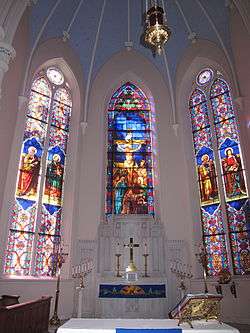Altar lamp
In many Christian churches there is an altar lamp, also known as a chancel lamp, which is found in the chancel (sanctuary), either hanging or fixed. In Anglican, Old Catholic and Roman Catholic churches, the chancel lamp burns before a tabernacle or ambry to demonstrate the belief that Christ is present there through His Real Presence, as the Blessed Sacrament is reserved in these denominations. It is also found in the chancel of Lutheran and Methodist churches to indicate the presence of Christ in the sanctuary, as well as a belief in the Real Presence of Christ in the Eucharist.[1][2] The sanctuary lamp may also be seen in Eastern Orthodox Churches. Other Christian denominations burn the lamp to show that the light of Christ always burns in a sin-darkened world.


With influence from Judaism in the Old Testament, God told Moses that a lamp filled with the pure oil should perpetually burn in the Tabernacle (Ex 27:20-21). This is the precedent for the custom in the Anglican Church and Catholic Church of burning a candle (at all times) before the tabernacle – the house where the Eucharistic Body of Christ is reserved under lock and key. In Jewish practice, this Altar lamp is known for its Hebrew name, Ner Tamid (Hebrew: "eternal flame or eternal light).[3] Many Christian churches have at least one lamp continually burning, often before an ambry or tabernacle, not only as an ornament of the altar, but for the purpose of worship. The General Instruction of the Roman Missal in the Catholic Church, for instance, states (in 316): "In accordance with traditional custom, near the tabernacle a special lamp, fueled by oil or wax, should be kept alight to indicate and honor the presence of Christ."
Such sanctuary or tabernacle lamps are often coloured red, though this is not prescribed by law. This serves to distinguish this light from other votive lights within the church. In the Catholic Church, red is widely used despite the preference for white expressed by Fortescue.[4] The use of multiple lights, always in odd numbers, i.e., three, five, seven, or more, in place of a single lamp has now become rarer, though it is still seen in some older Catholic churches and in eastern Christian churches. The lamp may be suspended by a rope or chain over the tabernacle or near the entry of the sanctuary, or it may be affixed to a wall; it is also sometimes placed on a ledge beside the tabernacle or on an individual stand placed on the floor, as seen in the image of St. Martin's church, Kortrijk, Belgium, in the article Church tabernacle. Oil lamps or candles may be used.
Olive oil used to be used for altar lamps and in the Catholic Church before Vatican II electric and gas lights were discouraged.[5]
See also
References
- The American Lutheran, Volumes 9-10. American Lutheran Publicity Bureau. 1926. p. 95.
Occasionally there is a sanctuary lamp over the altar, its pulsating red light symbolizing a belief in the Real Presence, and not necessarily indicating the reserved host, as is properly supposed.
- Hickman, Hoyt L. (1 July 2011). United Methodist Altars: A Guide for the Congregation (Revised Edition). Abingdon Press. ISBN 9781426730696.
Sanctuary lamp: A candle suspended from the ceiling or mounted on the wall near the Lord's table and constantly burning throughout the week, also referred to as an "eternal light." In Roman Catholic usage it signifies the presence of Christ in the reserved sacrament; in Protestant usage it signifies Christ's presence in the church.
- "Meaning of the Tabernacle Lamp in Catholic Churches". Taylor Marshall.
- Amator Liturgae (March 1920). "Studies and conferences:What is a rubrical altar?". The Ecclesiastical Review. 7. 62 (3): 289. Retrieved 2011-12-27.
There is,as he also notes, no authority whatever for the glass of the sanctuary lamp being other than white
- Herbermann, Charles, ed. (1913). . Catholic Encyclopedia. New York: Robert Appleton Company.
External links
![]()